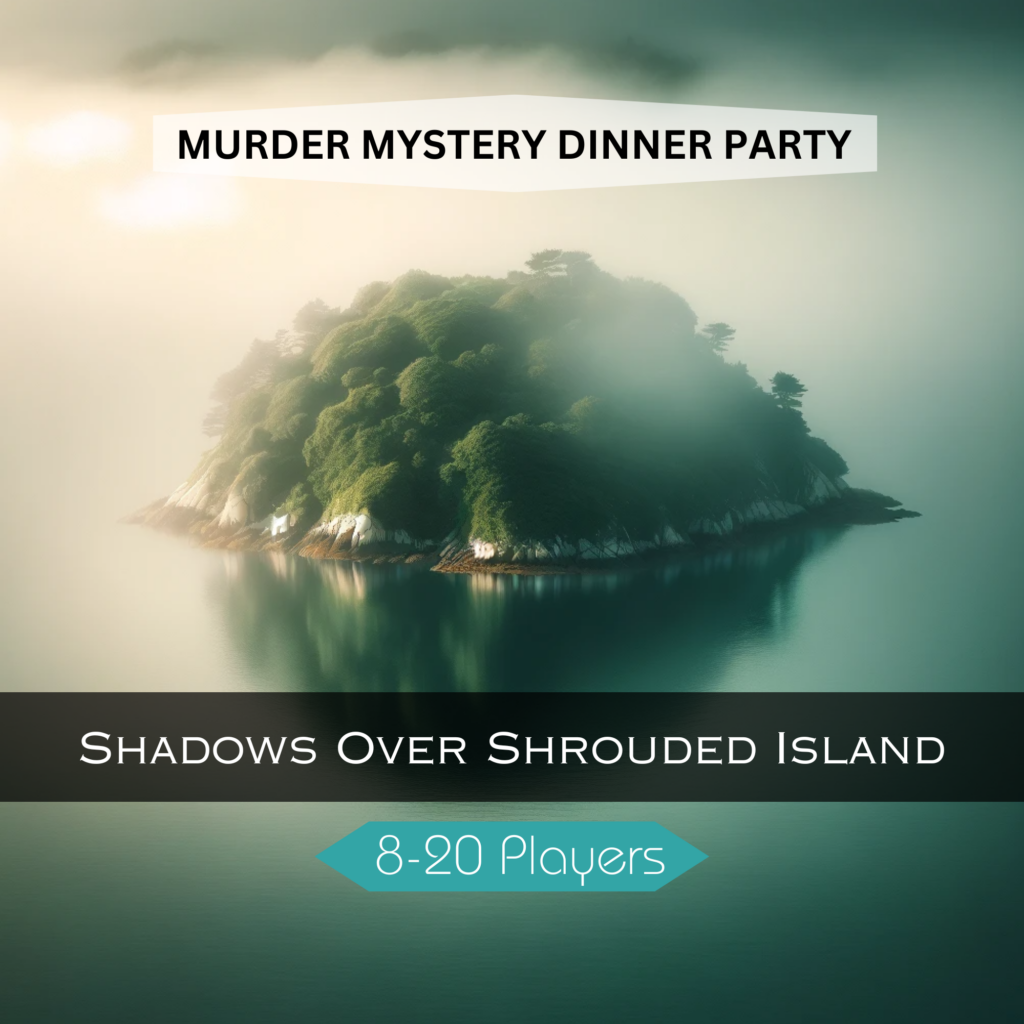How Many Guests Should I Invite to My Murder Mystery Party?: Inviting the right number of people to your party directly affects the dynamics of the game. It will influence your friends levels of participation and the feel of the event. If you invite too few guests, you won’t take full use of the variety of characters and you game might lack engagement. And if you invite too many it could develop into a more chaotic experience.
You will ideally be looking at 8-20 people in your game, and you’ll notice that most murder mystery party games will cater for this number. Personally, I recommend a maximum of 8 people for your very first party, and you can increase it with each additional one. It also allows you to replay the same murder mystery kit with a different group of 8 friends, without needing to purchase a whole new game.
Best Murder Mystery Party Game
You are Alex Bailey, an adventurer on the search for a mysterious island. You’ve brought together a group of experts to try aid you on your expedition, but not everyone can be trusted with the secrets of the island. After 3 people are murdered at your event, you must work together to try find the killer.
I. The Pros and Cons of Different Group Sizes
Murder mystery games can be split into small, medium, or large group games. Each size offers something a little different that can influence the game’s overall experience. Comparing the pros and cons can help you to decide on how many guests to invite. Take a look at these standard game sizes – along with their pros and cons:

1. Small Group Games (Approximately 6-8 Players):
- Pros:
- Intimacy and Depth: Smaller groups allow for more in-depth character development and deeper interaction among players. Each player gets more time focused on their character’s story.
- Easier Management: There are fewer characters to keep track of, so the game is easier to manage.
- Greater Participation: Each player’s involvement becomes crucial to the storyline. Everyone is a primary character, so they will need to participate fully.
- Cons:
- Limited Scope: With fewer characters, the plot might be less complex. This may reduce the challenge for more experienced players – thought this is dependent on the murder mystery kit you’re using.
- Less Social Diversity: Smaller groups tend to have less whacky interactions compared to larger groups. It can go either way with this one. I prefer smaller groups as an introvert, while my friends love large groups.
2. Medium Group Games (Approximately 9-14 Players):
- Pros:
- Balanced Dynamics: This size has better social diversity. You’ll have a lot more personalities without it being overwhelming.
- Richer Storylines: Medium-sized games will have more complex storylines. With additional characters, the scope of the story needs to expand as well.
- Cons:
- More Management: As the group size expands, you’ll need to be able to manage everyone and keep everyone engaged.
3. Large Group Games (Approximately 15+ Players):
- Pros:
- High Energy and Excitement: Large groups usually lead to a more lively atmosphere, with lots of big personalities.
- Diverse Interactions: With more players, the game is bound to see a lot more twists, turns and funny moments.
- Cons:
- Complex Management: You’ll have a lot more people to take care of during the evening. You’ll need to pretty good at managing your time.
- Can Become Overwhelming: With so many characters and lots of backstory, it may become overwhelming for some players or the host. You should definitely not attempt a 20-person murder mystery as your first one.

II. Understanding Murder Mystery Party Dynamics
There are a lot of small things that can affect your party size. Each one of these needs to be taken into account in order to have the best possible experience.
1. Character Allocation and Development: In a murder mystery game, each guest will play a specific character. These characters will all have a dress code, backstory, objectives, etc. So the number of people you invite will affect how many of these backstories get introduced into the game.
2. Engagement and Participation: You want the right number of people that you can help be actively involved in the game. If you’re planning alone, smaller groups are easier to manage. If you have help, then you can add as many as you want.
3. Group Dynamics: Smaller groups generally have more intimate and detailed interactions. Players have more time to express themselves and their theories. Larger groups will have a more lively atmosphere but can also lead to more distractions, and possibly derail the game’s focus.
4. Game Complexity and Duration: Generally, the more guests you have, the more difficult the game becomes. Characters normally have intertwined backstories, so as you add more characters, you create a larger web or secrets. A smaller group equals a more streamlined game. This could be good if your party has a set end time.
5. Managing the Plot and Clues: In murder mystery games, everyone needs time to look at the clues. In larger groups, the evidence needs to be passed around and there’s a lot more discussions taking place.
6. Flexibility in Storytelling: The number of players can also influence how rigid or flexible the game’s storyline can be. With fewer players, you might be able to edit characters names, backstory and secrets to make it more personalized without much problem. With a larger group this is all but impossible.
III. Consider the Size of Your Venue
How big is your place? Are you able to comfortably fit everyone on your guest list? Here are some tips to help you evaluate your space:
1. Movement and Interaction: Murder mystery games require guests to move around, mingle, and discuss theories. Take a walk through your space and imagine it filled with people. Is there enough room for guests to move about without feeling cramped? Are there spaces where small groups can gather for discussions?
2. Seating Arrangements: While much of the game will involve standing and talking, you’ll also need some seating. Friends might want to relax while you’re reading out the rules at the start, and during the final reveal. Make sure you have some seating available for those that want/need it. Remember, not everyone is comfortable spending 2-3 hours on their feet.
3. Breakout Areas: If you have the space, choose a few ‘breakout areas’ where smaller groups can go to discuss clues. These could be different rooms, corners of a large room, or even areas separated by furniture.
4. Use of Outdoor Spaces: You could also use your garden or patio as additional space for guests to spread out into. Make sure that outdoor areas are well-lit and safe for guests.
5. Decorations: Finally, think about where your food table will be, and any other decoration. Find places to place decorations that won’t overcrowd your home.
Tips for First-Time Murder Mystery Hosts
If you’re feeling a bit overwhelmed at all the things you need to keep track of – here are some tips tthat might help you out:
1. Choose the Right Game: You’ll want to choose something that you feel your friends will find interesting. It will also depend on the number of people you plan to invite. If you’re looking for something flexible that can be used for small, medium or large groups, try out Jazz, Moonshine and Murder.
2. Know the Story and Characters: Make sure you know the storyline inside out. You’ll be in charge of keeping track when each event needs to take place. It’s best to keep a printed timeline on you, and maybe even set timers on your phone. The more prepared you are, the easier things will go.
3. Send Out Invitations Early: If you want your friends to dress to impress, make sure you give them enough time to find the perfect costume. The sooner the better.
4. Set the Scene: Decorations are important. Try to decorate your space to match the theme of the mystery. You don’t need to go overboard – posters, lighting and music can be enough to create the right atmosphere.
5. Plan a Simple Menu: You’ll have enough on your plate managing the game, so try to keep your menu simple. Finger foods or a buffet are best as everyone can snack while they play.
6. Brief Your Guests: Before the game starts, read out the backstory and the rules. Your murder mystery kit will tell you exactly what you need to say, and what to keep secret.
7. Stay Flexible: Not everything will go to plan, and that’s okay. Embrace the mayhem. It’s all for a bit of fun anyway.
8. Keep the Pace: You’ll want to keep the game moving at a steady pace. You don’t want the game to drag on forever. If people look like their getting bored, you might want to introduce a timed event a bit earlier.
9. Enjoy Yourself: Last but not least, remember to have fun! If you’re having a good time, your guests will too.
How Many Guests Should I Invite to My Murder Mystery Party?
For first-timers, 8 people is the perfect amount. You’ll be able to tell from then onwards if you have the energy to host larger groups of friends. Extroverted hosts might want to increase the number after their first party, while introverted hosts may want to keep it the same. It’s really all about how much fun you and your friends have during the event.
If you can get assistance and not have to manage everything yourself, the party will become a lot more manageable. Have someone in charge of photography, or bring in a catering company if it’ll lessen your load. At the end of the night, you want it to be fun for you as well.














